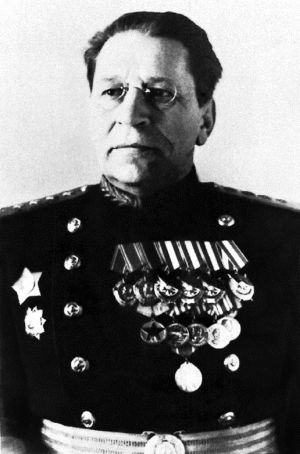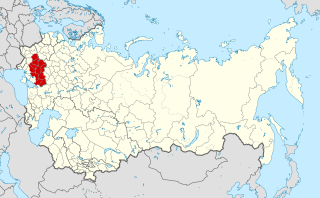
The Soviet Air Defence Forces was the air defence branch of the Soviet Armed Forces.

The 4th Panzer Army, operating as Panzer Group 4 from its formation on 15 February 1941 to 1 January 1942, was a German panzer formation during World War II. As a key armoured component of the Wehrmacht, the army took part in the crucial battles of the German-Soviet war of 1941–45, including Operation Barbarossa, the Battle of Moscow, the Battle of Stalingrad, the Battle of Kursk, and the 1943 Battle of Kiev.

Maksim Alexeyevich Purkayev was a Soviet military leader, reaching service rank of Army General.

The 24th Mechanized Brigade is a mechanized brigade of the Ukrainian Ground Forces, based at Yavoriv in the west of Ukraine.

The Kiev Military District was a military district of the Imperial Russian Army and subsequently of the Red Army and Soviet Armed Forces. It was first formed in 1862, and was headquartered in Kiev (Kyiv) for most of its existence.
The 3rd Shock Army was a field army of the Red Army formed during the Second World War. The "Shock" armies were created with the specific structure to engage and destroy significant enemy forces, and were reinforced with more armoured and artillery assets than other combined arms armies. Where necessary the Shock armies were reinforced with mechanised, tank, and cavalry units. During the Second World War, some Shock armies included armoured trains and air–sled equipped units.
The 8th Rifle Division was a military formation of the Soviet Union's Red Army in the Winter War, the Soviet invasion of Poland, and World War II. It was formed three times.
The Reserve Armies were a group of armies formed by the Soviet Union's Red Army during World War II. Formed to control the training of newly formed units in the rear areas and provide army level headquarters to reconstitute destroyed armies or to form new armies. The Reserve Armies provided the Soviet High Command with a quickly deployable army headquarters to help stem German breakthroughs in the early part of the war.

The 252nd Rifle Division was the eighth of a group of 10 regular rifle divisions formed from cadres of NKVD border and internal troops as standard Red Army rifle divisions, very shortly after the German invasion, in the Moscow Military District.

The Red Army's 60th Army was a Soviet field army during the Second World War. It was first formed in reserve in the Moscow Military District in October 1941, but soon was disbanded. It was formed a second time in July 1942, and continued in service until postwar. The 60th Army was commanded by Gen. Ivan Danilovich Chernyakhovsky for much of the war, and it was while in this command that he proved himself worthy to be promoted to the rank of General of the Army and command of a Front at the age of 38 years. Elements of the army went on to, among other things, liberate the Auschwitz concentration camp.
The 5th Guards Rifle Division was an infantry division of the Red Army in World War II. It fought at Kaluga, Orel, Moscow, Bryansk, Gorodok, and in Belorussia, East Prussia, and Kurland.
The 166th Rifle Division was an infantry division of the Soviet Union's Red Army that fought in World War II, formed twice. The division's first formation was formed in 1939 and wiped out in the Vyazma Pocket in October 1941. In January 1942, the division reformed. It fought in the Battle of Demyansk, the Battle of Kursk, Belgorod-Khar'kov Offensive Operation, Vitebsk–Orsha Offensive, Polotsk Offensive, Šiauliai Offensive, Riga Offensive and the Battle of Memel. It was awarded the Order of the Red Banner.
The 24th Tank Division was a tank division of the Soviet Union, formed twice. The division's first formation was formed in the spring of 1941 and fought in the Leningrad Strategic Defensive before being broken up into two smaller brigades. The division's second formation was originally formed in 1956 as the 24th Heavy Tank Division and became a regular tank division in 1957. It became a training division in 1960 and was redesignated the 54th District Training Center in 1987 before being disbanded in 1995.

The 149th Mixed Aviation Division was an aviation division of the Russian Air Force.
The 280th Rifle Division was an infantry division of the Soviet Union's Red Army during World War II, formed twice. It was first formed in the summer of 1941 and destroyed in the Bryansk pocket in the fall of 1941. The division was reformed in late December, and served throughout the war before being disbanded in 1946.
The 15th Rifle Corps was a rifle corps of the Red Army, formed five times; each formation was a distinct unit unrelated to the others. It was part of the 5th Army. It took part in the Soviet invasion of Poland in 1939.

The 24th Rifle Corps was a corps of the Red Army. It was part of the 27th Army and took part in the Great Patriotic War. It appears to have been initially formed in the Kalinin Military District, around what is today Tver, in 1939. In 1940 it was relocated to Soviet-occupied Latvia with units of the dissolved Latvian Army joining the corps.
The 121st Rifle Division was an infantry division of the Red Army during World War II.
The 226th Rifle Division was an infantry division of the Red Army, originally formed as one of the first reserve rifle divisions following the German invasion of the USSR. After being hastily organized it arrived at the front along the lower Dniepr River as part of 6th Army and in the wake of the German victory in the Kiev encirclement it fell back toward, and then past, Kharkiv and spent the winter fighting in this area. During the Second Battle of Kharkov in May 1942 it scored early successes but was soon forced back by counterattacking panzers and barely escaped destruction in the first phases of the German summer offensive. After rebuilding in the Reserve of the Supreme High Command the division returned to the front north of Stalingrad where it joined the 66th Army. It took heavy losses in one of the last efforts to break through to the city before Operation Uranus cut off the German 6th Army, but it still played an important role in the reduction of the pocket during Operation Ring and as a result was redesignated as the 95th Guards Rifle Division in May 1943.
The 6th Fighter Aviation Corps of Air Defence was a military formation of the Red Army Air Force Air Defense Aviation of the Soviet Armed Forces, which fought in the Great Patriotic War.









